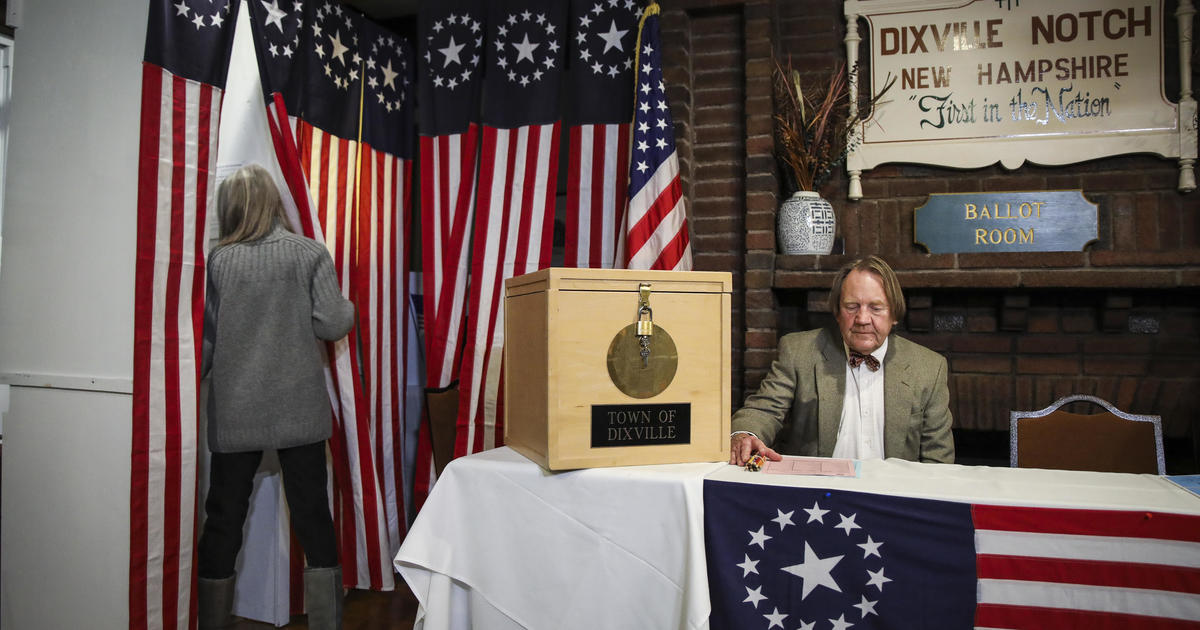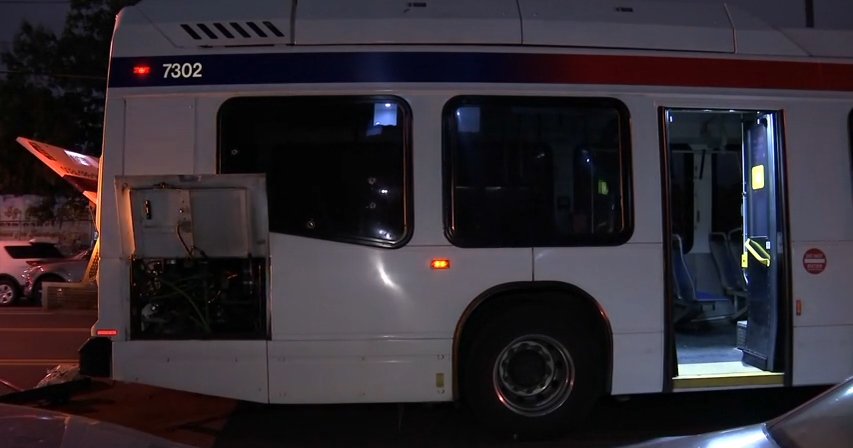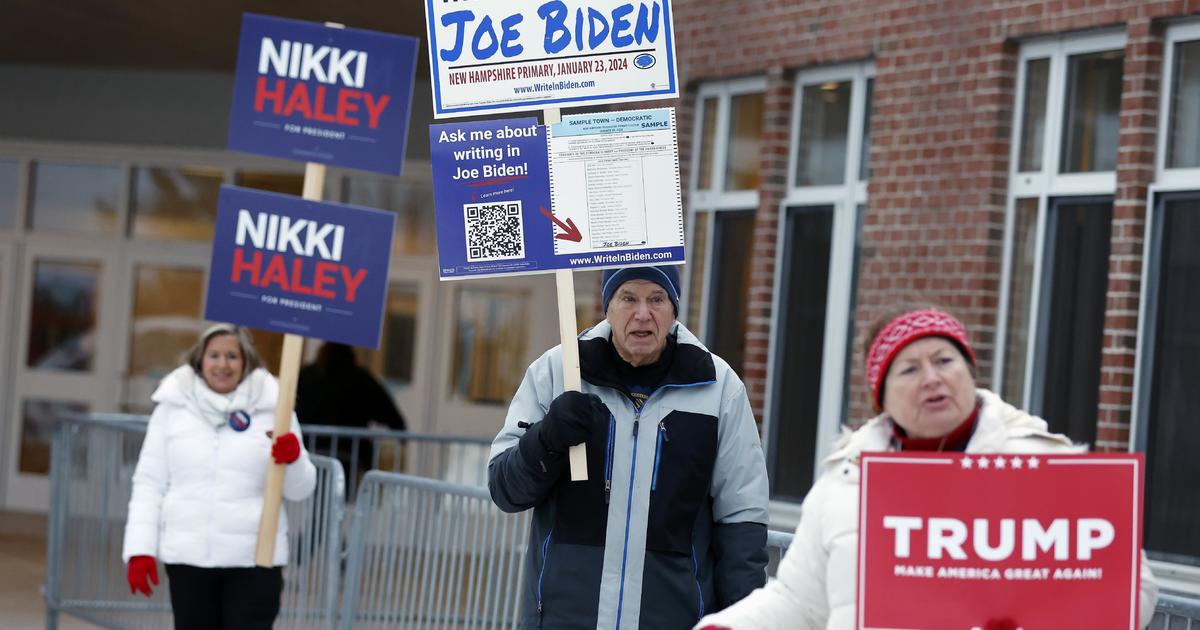CBS News
What is Dixville Notch? Why a small New Hampshire town holds their primary voting at midnight

Deep in New Hampshire’s North Country, a handful of civic-minded Americans in a small town called Dixville Notch will gather late into the night on Monday to cast the first votes of the state’s 2024 primary, continuing a decades-long tradition that has surprising roots.
All six of the unincorporated township’s registered voters — four Republicans and two independents, who also make up the entirety of the area’s population — must cast a ballot before the votes can be counted once midnight strikes, a process that typically takes just a few minutes.
Journalists and media outlets from around the world descend on the town every four years to witness the proceedings, hoping to divine some insight that might foreshadow the statewide results that will come into focus less than 24 hours later.
“We get our 15 minutes of fame every four years,” said Tom Tillotson, the town moderator, a post he’s held since 1976.
The tradition represents a marquee moment for the state, kickstarting the first primary in the nation in true Granite State fashion. But the future of the practice could be in doubt as the town’s population hovers near the minimum number of residents needed to keep it alive.
Where is Dixville Notch, and how did the tradition start?
Dixville Notch is in New Hampshire’s Great North Woods Region, just 20 miles southeast of the Canadian border. Its remote location played a role in developing the tradition of voting at midnight on the day of the presidential primary.
But the practice of late-night voting didn’t start in Dixville Notch. Another remote New Hampshire township, Hart’s Location, began voting early on primary day in 1948 to accommodate the irregular schedules of rail workers, according to the Associated Press. The practice stuck. (Hart’s Location was the inspiration for a thinly veiled episode of “The West Wing” in 2002 about a New Hampshire town called “Hartsfield’s Landing” that voted at midnight.)
Neil Tillotson, Tom’s father and his predecessor as town moderator, is credited with bringing the tradition to Dixville Notch. In 1954, Neil Tillotson moved to town and bought a local hotel, which he renamed The Balsams Grand Resort Hotel.
Eventually, he grew tired of driving 45 minutes, often in the snow, to reach the nearest polling station when it came time to vote. Tom Tillotson said his father first heard of the midnight voting process from an AP reporter. He and other residents banded together to ask the New Hampshire legislature to approve Dixville Notch as a standalone voting precinct.
“It’s an unincorporated township, and at that point, it wasn’t authorized to do anything,” Tom Tillotson said. “It was just a piece of land.”
In 1960, it was official, and the town held its first midnight vote.
“They got together, nine people, and voted at midnight,” Tillotson said. “I don’t think there was much press coverage that first year … but that started the tradition.”
Every presidential primary since, the late-night vote tallying has continued, even during the COVID-19 pandemic.
Erin Clark/The Boston Globe via Getty Images
While Dixville Notch wasn’t the first town to hold a midnight vote, the hotel was largely responsible for propelling the community to fame. The Balsams had the infrastructure — space, phone lines and a dark room — for reporters and photographers to produce and send out their stories and pictures.
“That infrastructure was much better than any of the other little towns, who basically met in somebody’s home, and for that reason, I guess the media that did cover it found it more convenient to cover Dixville than the other little towns,” Tillotson said.
This year, the two other locales known for the midnight vote — Hart’s Location and Millfield — aren’t expected to hold their votes at the late hour, due in part to aging populations that make midnight voting increasingly difficult.
The process of casting and counting votes can take a matter of minutes. Five voters are needed to serve as election workers and administer the vote. The town is allowed to count its tally before the rest of the state under a rule that says a polling place can close once every registered voter has cast a ballot.
“That’s the only reason why they can report their results so early,” said John Lappie, a political science professor at Plymouth State University. “If even one registered voter in the community doesn’t play ball, then you can’t announce the results shortly after midnight, like they do.”
For Tillotson, he says the tradition is something he “grew up on.” The process his father began in Dixville Notch is now broadcast live around the world every four years.
“It’s different. It’s not the same as everybody voting, because I do it in front of potentially millions of people,” he said. “But that being said, it’s an honor.”
Who has won Dixville Notch in the past?
Bettmann / Getty Images
On the Republican side, pundits and observers have taken note of Dixville Notch voters’ historic tendency to side with the eventual GOP nominee, a trend that began in 1968 and persisted with startling accuracy in every presidential primary until 2012.
But the voters have also been out of step with the broader electorate, especially in years with competitive Democratic primaries. In 2020, Michael Bloomberg won Dixville Notch with three write-in votes, while Bernie Sanders and John Kasich picked up the most votes in 2016.
Those looking for signals of how the statewide electorate is feeling about the candidates would do better searching elsewhere, Lappie said.
“It’s such a small sample size that if they’ve happened to get the candidates correct so often, that’s just a coincidence,” he said. “And Dixville Notch certainly isn’t representative of all New Hampshire.”
What is the population of Dixville Notch?
Central to the tradition is the community’s size. Since it got its start in 1960, the voting bloc swelled to 37 people at its peak in the 1980s. Ahead of the election in 2020, with just four anticipated voters, a dispute arose about whether the process could move forward.
“It was unclear whether or not that was enough people to hold an election,” Tillotson said.
But after one developer decided to move back to the area, Dixville Notch was allowed to proceed with five voters. This election cycle, they’ve added another new resident.
“We actually have six,” Tillotson said. “Population boom.”
What’s the future of the tradition?
For New Hampshire, the midnight voting tradition is deeply rooted, and emblematic of the state’s broader identity as a first-in-the nation primary contest that turns out large portions of Granite Staters every four years.
“The thing about New Hampshire is we’re a small, relatively cheap state to compete in. We’re a place where retail politics actually works,” Lappie said. “New Hampshire is a state that gives an underfunded underdog a place they can actually hope to compete in.”
Every election cycle, Dixville Notch’s residents wonder whether their midnight tradition will continue in four years, Tillotson said, as the population of registered voters hovers just above the minimum needed to administer an election.
But Tillotson explained that the biggest obstacle toward continuing the tradition would actually be if the town’s population swelled. And with the redevelopment of its hotel underway, there’s a chance the effort could be “too successful,” bringing in dozens of new residents.
“As you grow, it gets exponentially harder to get 100% participation,” Tillotson said. “The herding cats syndrome kind of sets in.”
CBS News
Former New York Gov. David Paterson, stepson attacked while walking in New York City

NEW YORK — Former New York Gov. David Paterson and his stepson were attacked in New York City on Friday night, authorities said.
The incident occurred just before 9 p.m. on Second Avenue near East 96th Street on the Upper East Side, according to the New York City Police Department.
Police said officers were sent to the scene after an assault was reported. When officers arrived, police say they found a 20-year-old man suffering from facial injuries and a 70-year-old man who had head pain. Both victims were taken to a local hospital in stable condition.
In a statement, a spokesperson for the former governor said the two were attacked while “taking a walk around the block near their home by some individuals that had a previous interaction with his stepson.”
The spokesperson said that they were injured “but were able to fight off their attackers.”
Both were taken to Cornell Hospital “as a precaution,” he added.
Police said no arrests have been made and the investigation is ongoing.
The 70-year-old Paterson, a Democrat, served as governor from 2008 to 2010, stepping into the post after the resignation of Eliot Spitzer following his prostitution scandal. He made history at the time as the state’s first-ever Black and legally blind governor.
CBS News
10/4: CBS Evening News – CBS News

Watch CBS News
Be the first to know
Get browser notifications for breaking news, live events, and exclusive reporting.
CBS News
Teen critically wounded in shooting on Philadelphia bus; one person in custody

A 17-year-old boy was critically injured and a person is in custody after a gunman opened fire on a SEPTA bus in North Philadelphia Friday evening, police said.
At around 6:15 p.m., Philadelphia police were notified about a shooting on a SEPTA bus traveling on Allegheny Avenue near 3rd and 4th streets in North Philadelphia, Inspector D F Pace told CBS News Philadelphia.
There were an estimated 30 people on the bus at the time of the shooting, Pace said, but only the 17-year-old boy was believed to have been shot. Investigators said they believe it was a targeted attack on the teenager and that he was shot in the back of the bus at close range.
According to Pace, the SEPTA bus driver alerted a control center about the shooting, which then relayed the message to Philadelphia police, who responded to the scene shortly.
Officers arrived at the scene and found at least one spent shell casing and blood on the bus, but no shooting victim, Pace said. Investigators later discovered the 17-year-old had been taken to Temple University Hospital where he is said to be in critical condition, according to police.
CBS Philadelphia
Through their preliminary investigation, police learned those involved in the SEPTA shooting may have fled in a silver-colored Kia.
Authorities then found a car matching the description of the Kia speeding in the area and a pursuit began, Pace said. Police got help from a PPD helicopter as they followed the Kia, which ended up crashing at 5th and Greenwood streets in East Mount Airy. Pace said the Kia crashed into a parked car.
The driver of the crashed car ran away but police were still able to take them into custody, Pace said.
Investigators believe there was a second person involved in the shooting who ran from the car before it crashed. Police said they believe this person escaped near Allegheny Avenue and 4th Street, leaving a coat behind.
According to Pace, police also found a gun and a group of spent shell casings believed to be involved in the shooting in the same area.
“It’s very possible that there may have been a shooting inside the bus and also shots fired from outside of the bus toward the bus,” Pace said, “We’re still trying to piece all that together at this time.”
This is an active investigation and police are reviewing surveillance footage from the SEPTA bus.










